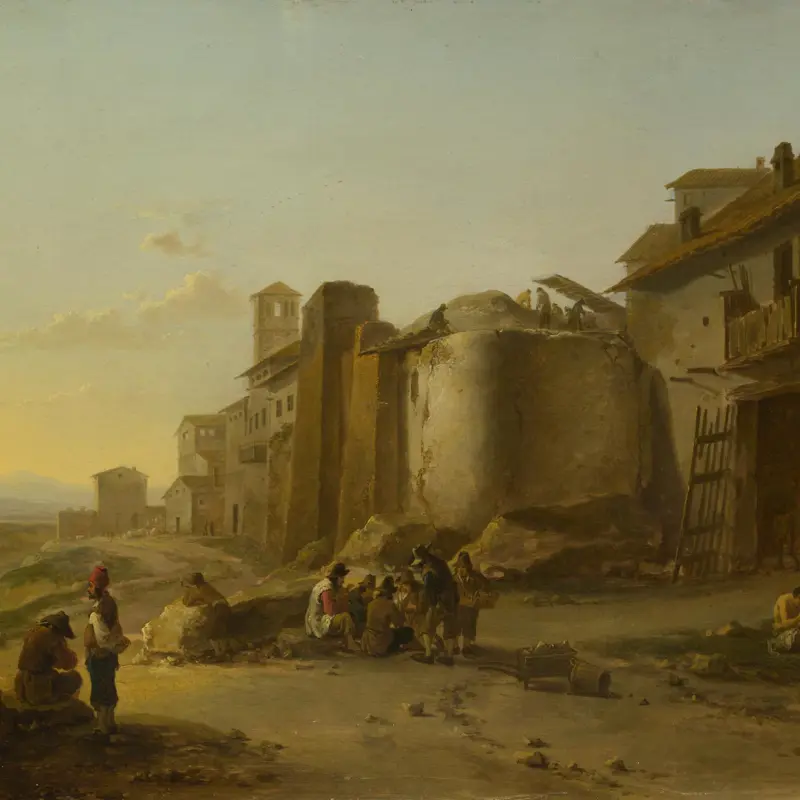Jan Both, 'Peasants with Mules and Oxen', about 1641-3
About the work
Overview
The sun sinks behind a steep Italian hillside, casting a soft, gold light over a meandering river in the valley below. But the chill of evening is perhaps settling in. Huddled in his coat, his hat well down over his ears, a man rides his mule side-saddle.
Behind them, a peasant drives two oxen down the mountain path. He raises his hand as if his attention has been caught, perhaps by a bird. A leafless tree on the right saves the scene from becoming too idyllic, its harsh, angular shape contrasting with the soft, fine leaves of the beech trees.
Jan Both came from Utrecht; young painters from here often crossed the Alps for a stay in Italy. He lived in Rome, and went out into the countryside to sketch from nature. When he returned to Utrecht, Jan turned his raw material into a series of landscapes suffused by a rich, golden light, which were popular with Dutch collectors.
Key facts
Details
- Full title
- Peasants with Mules and Oxen on a Track near a River
- Artist
- Jan Both
- Artist dates
- About 1615 - 1652
- Date made
- About 1641-3
- Medium and support
- Oil on copper
- Dimensions
- 39.6 × 58.1 cm
- Inscription summary
- Signed
- Acquisition credit
- Wynn Ellis Bequest, 1876
- Inventory number
- NG959
- Location
- Not on display
- Collection
- Main Collection
- Previous owners
- Frame
- 20th-century Replica Frame
Provenance
Additional information
Text extracted from the ‘Provenance’ section of the catalogue entry in Neil MacLaren, revised and expanded by Christopher Brown, ‘National Gallery Catalogues: The Dutch School: 1600–1900’, London 1991; for further information, see the full catalogue entry.
Exhibition history
-
2014Making ColourThe National Gallery (London)18 June 2014 - 7 September 2014
Bibliography
-
1829
J. Smith, A Catalogue Raisonné of the Works of the Most Eminent Dutch, Flemish, and French Painters: In Which is Included a Short Biographical Notice of the Artists, with a Copious Description of Their Principal Pictures […], 9 vols, London 1829-1842
-
1907C. Hofstede de Groot, Catalogue Raisonné of the Works of the Most Eminent Dutch Painters of the Seventeenth Century, 10 vols, London 1907
-
1907C. Hofstede de Groot, Catalogue Raisonné of the Works of the Most Eminent Dutch Painters of the Seventeenth Century, 10 vols, London 1907
-
1960Maclaren, Neil, National Gallery Catalogues: The Dutch School, 2 vols, London 1960
-
1982D. Gordon, The National Gallery Lends: Paintings of the Warm South by Foreign Painters in Italy in the Seventeenth Century (exh. cat. Herbert Art Gallery, 13 March - 25 April 1982; Derby Art Gallery, 8 May - 12 June 1982; Doncaster Museum and Art Gallery, 19 June - 25 July 1982; Victoria Art Gallery, 6 August - 4 September 1982), Coventry 1982
-
1983C. Brown, 'Rubens' Watering Place: An Examination of His Landscape Technique', Ringling Museum of Art Journal, 1983, pp. 130-49
-
1990I. Gaskell, National Gallery Master Paintings from the Collection of Wynn Ellis of Whitstable, London 1990
-
1991Maclaren, Neil, revised by Christopher Brown, National Gallery Catalogues: The Dutch School, 1600-1900, 2nd edn (revised and expanded), 2 vols, London 1991
-
1997C. Brown, Utrecht Painters of the Dutch Golden Age (exh. cat. Fine Arts Museums of San Francisco, 13 September - 30 November 1997; Walters Art Gallery, 11 January - 5 April 1998; The National Gallery, London, 6 May - 2 August 1998), San Francisco 1997
-
1997J.A. Spicer and L.F. Orr, Masters of Light: Dutch Painting from Utrecht in the Golden Age (exh. cat. Fine Arts Museums, 13 September - 30 November 1997; Walters Art Gallery, 11 January - 5 April 1998; The National Gallery, London, 6 May - 2 August 1998), San Francisco 1997
-
2001
C. Baker and T. Henry, The National Gallery: Complete Illustrated Catalogue, London 2001
About this record
If you know more about this work or have spotted an error, please contact us. Please note that exhibition histories are listed from 2009 onwards. Bibliographies may not be complete; more comprehensive information is available in the National Gallery Library.






